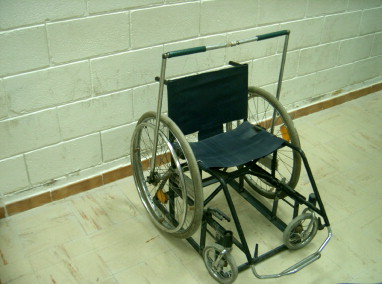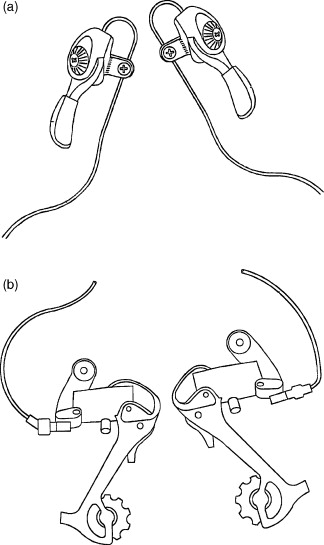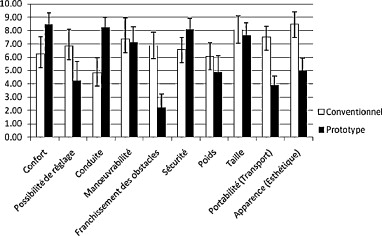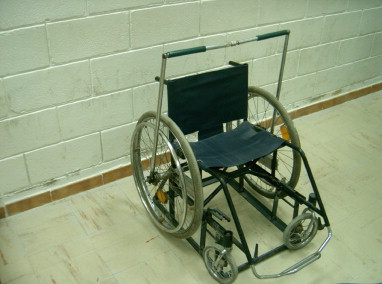Abstract
Objective
To evaluate the results of a user satisfaction questionnaire on a new type of lever-propelled wheelchair designed to avoid the discomfort and potential repetitive strain injuries related to conventional hand-rim propulsion.
Methods
Seventeen participants filled out a questionnaire to rate their conventional wheelchair and the prototype (after 2 days’ use) in terms of comfort, adjustability, steering/ride, manoeuvrability, stability when crossing obstacles, safety, weight, size, portability and appearance. Overall satisfaction was also scored.
Results
According to the user questionnaire results, the lever-propelled prototype chair was rated as significantly superior than conventional wheelchairs in terms of comfort, safety and overall satisfaction. The prototype was rated significantly inferior in terms of size, adaptability, appearance and crossing obstacles.
Conclusion
We conclude that the prototype wheelchair is highly acceptable and comfortable and can be recommended to disabled sportspersons. The prototype’s weak points are mainly related to ergonomic aspects, which could be improved in future models.
Résumé
Objectifs
Un nouveau prototype de fauteuil roulant, basé sur la technique de propulsion à leviers, a été conçu dans l’objectif de prévenir les complications et les contraintes reliées à l’acte de propulsion conventionnelle. Une évaluation subjective de ce nouveau prototype a été effectuée à travers un questionnaire.
Matériels et méthodes
Un questionnaire comprenant des questions sur le confort, la possibilité de réglage des différents accessoires, la conduite, la manœuvrabilité, le franchissement des obstacles, la sécurité du fauteuil, son poids, sa taille, sa portabilité ainsi que son apparence a été adressé à des utilisateurs de ce prototype. Une note de satisfaction globale de la propulsion du prototype a été également demandée. Dix-sept personnes ont participé à cette étude en utilisant le prototype au minimum deux jours avant leurs réponses au questionnaire.
Résultats
Les résultats montrent que le prototype a été jugé supérieur au fauteuil conventionnel sur le plan du confort et de la sécurité ressentis lors de la propulsion non-conventionnelle ainsi que sur le plan de la satisfaction globale. Le prototype a été trouvé inférieur au fauteuil conventionnel concernant la taille, la possibilité des réglages, le franchissement d’obstacles et l’apparence.
Conclusion
Nous pouvons conclure que le prototype du fauteuil roulant a été largement accepté par les utilisateurs et pourrait être recommandé dans le domaine de l’handisport. Les points faibles du prototype pourraient être liés probablement à des facteurs ergonomiques qui doivent être améliorés dans les futurs prototypes.
1
English version
1.1
Introduction
When gait becomes impossible following spinal cord injuries or any disease affecting the lower limbs, the patient try to find other modalities of transport compensating his/her functional disability. Wheelchair is the most commonly used device in these situations . It enables transport, transfers and even sport activities.
By enabling mobility, the wheelchair is extremely important for the functional independence of disabled people . However, users of conventional wheelchairs may (to a varying extent) experience repetitive strain injuries affecting mainly the arms and shoulders (which are exposed to significant biomechanical stress during propulsion) and frequently appear in young disabled sportspersons who use their wheelchair in competition .
Several authors have attempted to analyze conventional “hand-rim” propulsion and its effects on the upper limbs . Other researchers have performed magnetic resonance imaging of the shoulders in order to evaluate the involved anatomical structures . Even though no overall solution to this problem has been found, a number of studies have suggested alternative motor strategies or the provision of better training in terms of the conventional technique .
Studies on alternative lever- or crank-based propulsion techniques have shown that the latter are less stressful for the upper limbs and have a higher mechanical efficiency than conventional techniques .
In the literature, several innovations based on adaptation of a conventional wheelchair with a push-lever propulsion system have been described . However, to the best of our knowledge, none of these trials involved scientific analysis of any of the prototypes reporting various related problems, particularly in terms of handling ability 1
1 Handling ability refers to the wheelchair’s aptitude to react appropriately to the user’s attempts to manoeuvre.
and the user-prototype interface.Although, wheelchair–user interface is the most interesting factor conditioning the wheelchair design process . Integration of a new mechanical system and modification of the propulsion technique can affect this interface in a positive or negative manner. Portability, maintenance requirements, propulsion technique and wheelchair dimensions are important factors conditioning the satisfaction attributed to a new wheelchair.
The objective of the present article was to evaluate user satisfaction of a new wheelchair prototype with a lever-based manual propulsion technique. Handling ability (related to the prototype-user interface) and other parameters were evaluated with a user self-questionnaire. Data was collected after 2 days of practice on the new prototype.
1.2
Description of the prototype
Our prototype is an adjusted non-folding, lightweight Quickie GT ® , integrating a system of drive chains and freewheels linked to a two-handed, push bars placed in front of the user. The push-bars are linked to the wheelchair’s rear wheel axles on each side ( Fig. 1 and 2 ). Brake calipers are fitted on the chassis behind the back wheel and can be activated by brake levers fitted onto the push-bars ( Fig. 3 ). None of the other mechanical components of the conventional wheelchair were modified. The prototype was a subject of a publication elsewhere .



1.3
The questionnaire’s objectives
The objectives are described as follows:
- •
to identify the prototype’s advantages and disadvantages in different conditions;
- •
help us in improving the prototype’s design;
- •
to evaluate the user’s overall satisfaction with the prototype’s push-bar propulsion system.
1.4
Methodology
1.4.1
Population
Seventeen volunteers (11 men and six women) has participated in the study. Participant’s examination has confirmed the absence of any shoulder problems and has all a minimum of 2 years experience in sport wheelchair. Subjects are spinal cord injured, polio sufferers and lower leg amputees patients.
Disabled athletes suffering from neuromuscular diseases and hip amputees were excluded from the study, considering their significant invalidity and the likely bias on questionnaire results. Individuals were also excluded if they reported a history of musculoskeletal disorders affecting shoulder, neck and lower back. Traumatic and psychiatric disorders within the previous year are also criteria for excluding.
Participants presented with spinal cord injury must have a spinal level lesion at T10 and below to avoid significant impairment of abdominal muscle, which can affect the reliability of the experimental results.
Participant characteristics are presented in Table 1 .
| Age (years) | Body weight (kg) | Experience of wheelchair sport (years) | Experience of manual propulsion (years) | |
|---|---|---|---|---|
| Males ( n = 11) | ||||
| Paraplegic spinal cord injured ( n = 6) | 35 | 62.3 | 9 | 12 |
| 31 | 71 | 6 | 7 | |
| 27 | 79 | 3 | 2 | |
| 24 | 67.4 | 4 | 3 | |
| 29 | 69.2 | 6 | 4 | |
| 26 | 74.4 | 5 | 2 | |
| Poliomyelitis athletes ( n = 3) | 31 | 59.6 | 10 | 4 |
| 29 | 61.3 | 5 | 3 | |
| 26 | 62.3 | 4 | 3 | |
| Lower leg amputees ( n = 2) | 37 | 51.9 | 3 | 2 |
| 34 | 59.2 | 4 | 2 | |
| Females ( n = 6) | ||||
| Paraplegic spinal cord injured patients ( n = 5) | 27 | 49.5 | 5 | 2 |
| 25 | 51.3 | 7 | 4 | |
| 29 | 59.6 | 4 | 2 | |
| 24 | 52 | 6 | 3 | |
| 22 | 61 | 3 | 2 | |
| Poliomyelitis athletes ( n = 1) | 37 | 48 | 7 | 5 |
1.4.2
Questionnaire content and evaluation
Before filling out the questionnaire, each subject provided information on his/her medical history and his/her prior experience in hand-rim propulsion wheelchairs. The subjects’ profiles were evaluated in terms of their disability, needs, sporting activities and experience of wheelchair use and certain anthropometric parameters.
We asked each subject to use the non-conventional propulsion wheelchair for at least 2 days before filling out the questionnaire. This period enabled users to become relatively experienced in the new non-conventional propulsion system and give more accurate answers to the different questionnaire items. The wheelchair had to be used for activities of daily living for at least 2 hours a day.
The questionnaire included questions on comfort, adjustability of various accessories, ride, manoeuvrability 2
2 Manoeuvrability refers to the wheelchair’s intrinsic qualities when required to perform certain types of manoeuvres.
, crossing obstacles, safety, weight, size, portability and appearance. Overall satisfaction with the prototype’s non-conventional propulsion system was also scored (see the Appendix A ). For all items, a score of 0 corresponded to “very unsatisfied”, whereas a score of 10 corresponded to “very satisfied”.The study was performed over a 1-year period at the basketball court at Balamand University (Lebanon). All the disabled athletes were patients being monitored in our physiotherapy service at the Rahme Rehabilitation Hospital and the Social Services Association (Tripoli, Lebanon).
The therapists who supervised the questionnaire-based data collection with the prototype users had been selected for their experience of wheelchair sports training. However, this group was blinded to the specific study objectives.
1.4.3
Statistical analysis
All statistical analysis were performed using SPSS software (version 16) and Microsoft Excel 2007.
For each questionnaire item, scores for a conventional wheelchair and those for the prototype were compared in a paired Student’s t test for normally distributed variables. Results has been considered as significant when p < 0.05.
1.5
Results
The user questionnaire results are presented graphically in Fig. 4 , with the items on the horizontal axis and the mean (± standard deviation) score on the vertical axis.

1.5.1
User comfort
The mean score for the prototype was 2.25 points higher than that of the conventional wheelchair. This difference was statistically significant ( p < 0.0001).
1.5.2
Adjustability (especially the prototype’s push bar)
The mean score for the conventional wheelchair was 2.625 points higher than that of the prototype. This difference was statistically significant ( p < 0.0001).
1.5.3
Ride
The mean score for the prototype was 3.438 points higher than that of the conventional wheelchair. This difference was statistically significant ( p < 0.0001).
1.5.4
Manoeuvrability
The mean score for the conventional wheelchair was 0.125 points higher than that of the prototype. This difference was not significant ( p < 0.802).
1.5.5
Crossing obstacles
The mean score for the conventional wheelchair was 4.625 points higher than that of the prototype. This difference was statistically significant ( p < 0.0001).
1.5.6
Safety
The mean score for the prototype was 1.563 points higher than that of the conventional wheelchair. This difference was statistically significant ( p < 0.0001).
1.5.7
Weight
The mean score for the conventional wheelchair was 1.188 points higher than that of the prototype. This difference was statistically significant ( p < 0.003).
1.5.8
Size
The mean score for the conventional wheelchair was 0.313 points higher than that of the prototype. The difference was not significant ( p < 0.367).
1.5.9
Portability
The mean score for the conventional wheelchair was 3.688 points higher than that of the prototype. This difference was statistically significant ( p < 0.0001).
1.5.10
Aesthetic appearance
The mean score for the conventional wheelchair was 3.375 points higher than that of the prototype. This difference was statistically significant ( p < 0.0001).
1.5.11
Overall satisfaction
The mean score for the prototype was 3.813 points higher than that of the conventional wheelchair. This difference was statistically significant ( p < 0.0001).
1.6
Discussion
Our survey was based on user evaluations of new wheelchair models described by other authors and on the questionnaire developed by Gaines et al. validating a new type of hand-rim .
Analysis of the questionnaire results showed that the prototype has minor and major problems. The problems raised by the users concerned its portability, weight, size, ability to cross obstacles and the adjustability of certain accessories (the add-on push bar).
In the other hand, the results of the questionnaire suggest that the prototype wheelchair is superior on a number of factors including user comfort, ride and safety. Furthermore, the non-conventional prototype was awarded a higher overall satisfaction score.
We can thus say that the prototype wheelchair (based on a non-conventional, lever-based propulsion system) is nearly identical to the conventional wheelchair from a mechanical point of view. The wheels, seat, height and dimensions have not been modified. However, any modification of the propulsion technique can affect the wheelchair–user interface.
The critical interface between a user and his/her wheelchair is a very important issue for manufacturers and the designers. The subject must be able to control the wheelchair (mainly during outdoor or sporting activities) with minimal physical and cognitive efforts.
The study questionnaire aimed at subjectively evaluating the prototype and the associated constraints and problems. However, we still consider that the prototype is a prototype and wish to emphasize the fact that ergonomic adjustments specifically related to the propulsion bar had not been taken into consideration prior to performance of the survey.
When using conventional wheelchairs, disabled athletes can encounter physical and cognitive difficulties and constraints. This results from harmful overuse of the arm joints caused by microtrauma and other overloads during activities of daily living (transfers, getting out of bed, exercise, etc.) and sporting events.
The strain related to manual propulsion has been frequently reported in the literature (mainly in surveys of spinal cord injured patients) .
The user evaluation of our prototype did not report any discomfort in the arms and thus contrasted with the strain induced by hand-rim propulsion of a conventional wheelchair. Similarly, the users’ general comments, as reported by the investigating therapists, confirmed the superiority of this type of lever-based propulsion.
In fact, these comments and testimonies showed that in addition to the wheelchair users’ physical characteristics, several other elements (related to the users’ attitudes, interests and cognitive profile over time) must be taken into consideration when ensuring the compatibility of the subject-prototype interface. Manoeuvrability, safety, the potential purchase price, aesthetics, adaptability and the precision and ease of displacement were the most cited factors.
In terms of manoeuvrability, the user must feel as if he/she is in full command of the wheelchair at all times. If this is not the case, the subject may experience frustration and/or passivity.
The wheelchair or prototype must also offer the user a good level of safety – notably during extreme use and even if a part fails.
In terms of the cost, the prototype appears to be potentially marketable. However, integration of the non-conventional manual propulsion technique will be complex. In addition to ergonomic adjustments, it will be necessary to use lightweight material for the push-bars so as not to raise the weight of the wheelchair while keeping the final product at a reasonable price.
In terms of optimal user-device interaction and responsiveness, the new wheelchair must offer the user a high level of handling precision (particularly when used for sport). It must avoid the repetitive strain problems associated with conventional wheelchairs but must not become less mechanically efficient. When participating in sporting events or during activities of daily living, the user and the wheelchair must interact harmoniously. Significant cognitive and physical overload is produced when the user’s attempts to achieve high performance levels during sport-specific movements are confounded by a poor response from his/her wheelchair.
With respect to adaptability, the wheelchair’s interface must be suited to the user’s characteristics (such as height and weight).
It is also necessary to take into account the context of the wheelchair’s use and offer the user the time required to perform the appropriate movement in each situation.
The present study showed that modification of the conventional manual propulsion technique (with a view to improving conditions of use, relative to a conventional wheelchair) has broad potential for adoption by disabled sportspeople. Our results have been validated with paraplegics, poliomyelitis athletes and lower leg amputees. These types of invalidity encompass most of the people using wheelchairs under extreme conditions (e.g. sporting activity).
The feedback from prototype users revealed that the new design was acceptable and presented advantages over conventional wheelchair models with standard hand-rim propulsion. User-rated comfort and overall satisfaction with the prototype demonstrated the correlation between improvements in propulsion and the change in technique. Safety and steering/ride were also satisfactory. However, adjustability, manoeuvrability, the ability to cross obstacles, weight, size and portability were judged by the users to be unsatisfactory. The difficulties encountered during use of the prototype are probably due to ergonomic aspects that have yet to be addressed.
The study’s limitations must be borne in mind (notably those related to the small sample size and the heterogeneity of the surveyed users). It should also be noted that the users spent a very short time using the prototype (between 2 and 7 days), relative to their experience of a conventional wheelchair; this gave the users relatively little time to become accustomed to the prototype’s novel propulsion technique.
1.7
Conclusion
Standard hand-rim propulsion is known to be responsible for most of the muscle and skeletal disorders of the arms experienced by wheelchair users and for the low mechanical yield of conventional techniques.
Models with non-conventional propulsion systems (such as the lever-based system studied here) are essential and have many advantages.
In the future, we hope to be able to avoid the disadvantages related to:
- •
the prototype’s mechanical design;
- •
ergonomic measurements;
- •
certain awkward movements;
- •
a non-optimal interface for evaluating certain movements in the field.
Modification of the wheelchair’s mechanical systems (notably those of the wheels) and push bar may overcome these problems.
Our prototype is an attempt to promote the integration of a push lever-based manual propulsion technique in disabled sport, so that paraplegic and handicapped sportspersons can avoid the repetitive strain injuries induced by the conventional hand-rim technique as much as possible. This improvement in manual wheelchair propulsion should significantly improve the quality of life for disabled sportspeople. The prototype could be used in many types of wheelchair sport, ranging from table tennis to track racing and even the marathon.
2
Version française
2.1
Introduction
Lorsque la marche s’avère impossible suite à un accident ou à une maladie invalidante, le patient doit chercher un mode de déplacement qui va compenser cette fonction conditionnant sa vie. Or, le fauteuil roulant est l’aide technique la plus précieuse pour la plupart de ces sujets . Il assure le déplacement, les transferts et même l’activité sportive.
En assurant la mobilité, le fauteuil roulant est extrêmement important pour l’indépendance fonctionnelle des personnes handicapées physiques .
En revanche, les utilisateurs d’un fauteuil conventionnel vont avoir des complications plus ou moins sévères, surtout au niveau des membres supérieurs qui subissent des contraintes biomécaniques importantes induites par l’acte de propulsion. Ces manifestations apparaissent fréquemment chez des jeunes sportifs handicapés qui utilisent le fauteuil dans le cadre d’activités intenses .
Plusieurs auteurs ont tenté d’analyser l’acte de propulsion conventionnelle dite par « main courante » et ses effets sur les membres supérieurs , d’autres ont pratiqué des clichés d’IRM pour les épaules afin d’évaluer les différentes structures anatomiques mises en jeu . Si aucune étude n’a permis de trouver de solution à cette problématique, d’autres ont proposé soit un changement de la stratégie motrice soit un apprentissage supplémentaire de la technique .
Des études faites sur des techniques de propulsion alternatives à leviers et à manivelles ont montré que ces techniques sont moins contraignantes pour les membres supérieurs et possède un rendement mécanique supérieur à celui de la technique conventionnelle .
Dans la littérature, plusieurs tentatives d’innovation basées sur l’intégration du système de leviers de poussée dans un fauteuil à propulsion manuelle conventionnelle ont été décrites . Cependant, à notre connaissance, aucune de ces tentatives n’a fait l’objet d’un travail scientifique mettant au point les différents problèmes rencontrés surtout en relation avec la maniabilité 3
3 La maniabilité désigne la plus ou moins bonne aptitude du fauteuil roulant à réagir aux sollicitations de son utilisateur pour effectuer les manœuvres désirées.
et l’interface sujet-prototype.L’interface fauteuil–utilisateur est le facteur le plus intéressant et le moins explicite dans la conception de n’importe quel fauteuil roulant . L’intégration d’une composante mécanique ainsi qu’une modification de la technique de propulsion peuvent influencer, positivement ou négativement, cette interface. La portabilité, la maintenance, la technique de propulsion et la taille sont autant de facteurs de satisfaction inhérents à un modèle de propulsion manuelle afin de favoriser l’interaction entre l’homme et la machine.
L’objectif de cet article est d’identifier et de quantifier la satisfaction des utilisateurs d’un prototype du fauteuil roulant équipée d’un système alternatif de propulsion manuelle basé sur le système des leviers. L’évaluation de la maniabilité, en relation avec l’interface prototype-utilisateur, est subjectivement évaluée par un questionnaire de satisfaction des différents paramètres. Un recueil des données a été fait après une utilisation du prototype basé sur la propulsion manuelle non-conventionnelle.
2.2
Description du prototype
Notre prototype a été conçu à l’aide d’un système de chaînes de bicyclette relié aux deux poignées de poussée. Ces deux poignées de poussée servent comme des leviers à la portée de l’utilisateur qui les prend par ses deux mains. Ces leviers ont été fixés et reliés aux deux axes des roues-arrière principales du fauteuil roulant ( Fig. 1 et 2 ). Des étriers de frein sont montés sur le châssis derrière la roue arrière et activés par des poignées de frein montées sur les poignées de poussée ( Fig. 3 ). Les accessoires et les composantes mécaniques du fauteuil, type Quickie GT ® : ultraléger et non-pliable, sont restés les mêmes. Notre prototype a été l’objet d’une étude expérimentale publiée .










